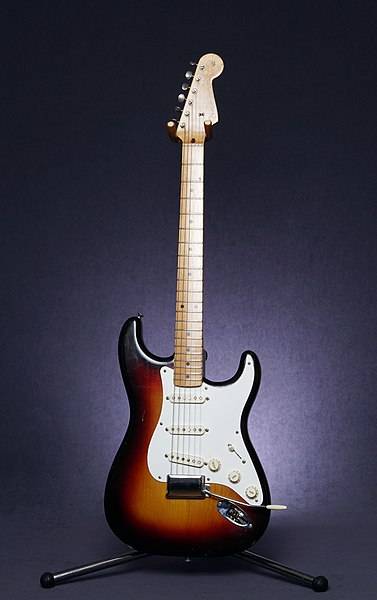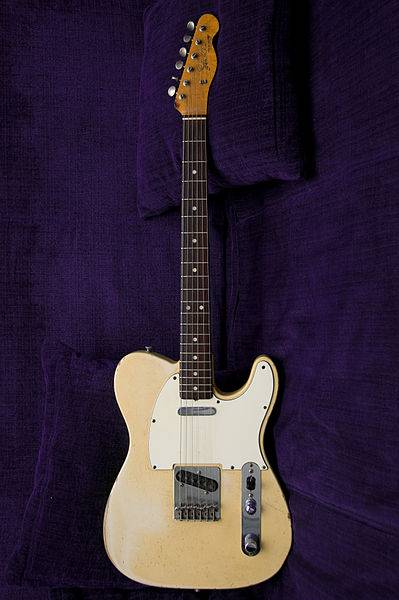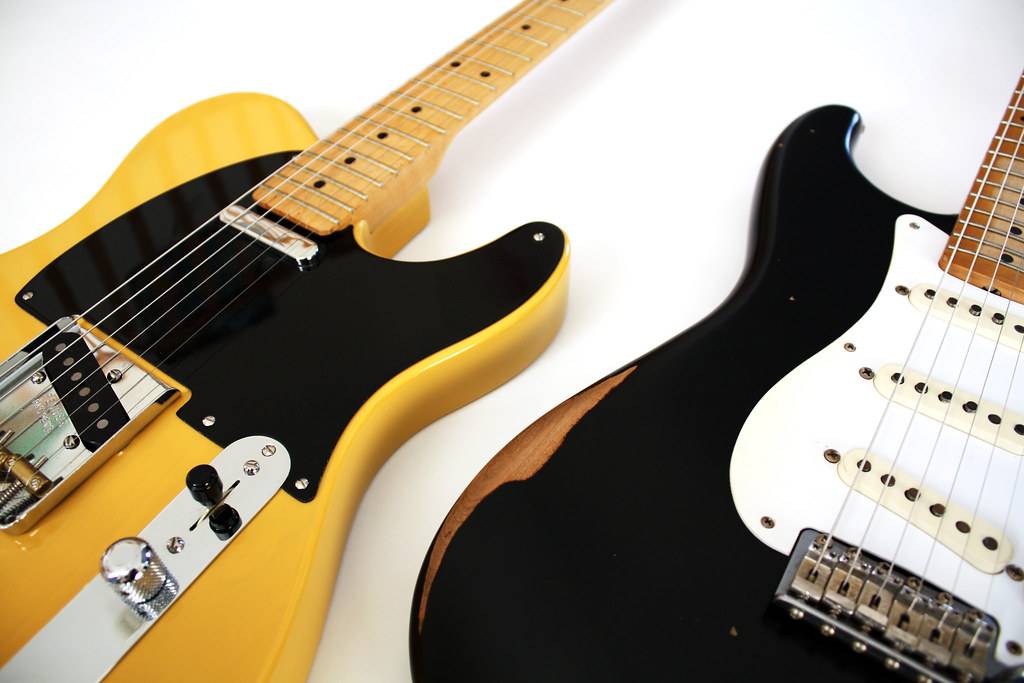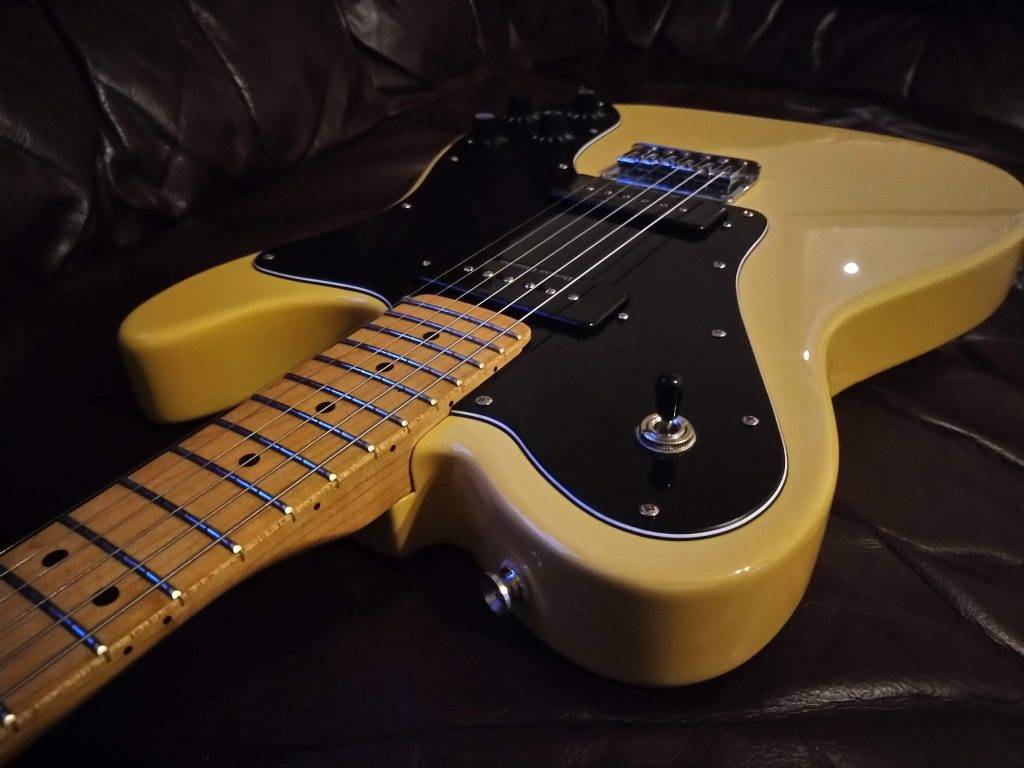Fender Stratocaster vs Telecaster. Resolving the timeless debate between two of the greatest guitars ever made. So which is the best?
The Fender Stratocaster vs Telecaster debate is well documented and has gone on for over half a century. Here’s my own take on it.
Fender Stratocaster vs Telecaster – Playability
With regard to neck dimensions at least, Teles and Strats could be identical, depending on the model. Personally, the slickest playing guitars I’ve ever owned happened to be Strats. As detailed here, they’re a better fit for me, with the Telecasters I’ve owned being a little too cramped with regard to neck width.
The Fender Stratocaster – 10
The Fender Telecaster – 9
Ergonomics and Design
What’s not up for debate is the superior contouring of the Fender Stratocaster. Not only do you get belly and arm contours as standard, but also an extra cutaway allowing for far superior upper fret access. The strat is more comfortable (perhaps the most comfortable) guitar to play, which is a massive factor, especially for lengthy gigs or sessions.
The traditional Tele Jack socket is its Achilles heel, and eventually, it WILL break as it’s held together by a single (bendable) retainer clip. There are workarounds to this of course (The electro-socket or a Gibson-style replacement), but here we’re dealing with standard spec vs standard spec. By contrast, the Stratocaster jack socket has a far more effective (and worry-free) screw + nut arrangement. I’ve owned two Teles, the clip went on one of them and the other I only had for a month.
The Fender Stratocaster has been described by none other than Eric Clapton as the ‘Perfect Electric Guitar’. It sort of is, design-wise at least. Futuristic, even today, a Telecaster v2 if you will.
… But then again. There are some who believe Leo Fender got it right on his first attempt. Personally, I love the Teles simpler design. A master tone and volume + 3 way. It’s less fiddly than the Strat’s one volume, two tones, and a five-way. Less is more. It’s just that the Strat’s controls are more closely positioned to aid violin-ing techniques etc.
I’ve moved around with many guitars and tried many different things, and I’ve always come back to the Stratocaster”. Eric Clapton
The Fender Stratocaster – 10
The Fender Telecaster – 8
Fender Stratocaster vs Telecaster – Durability/Stability
A close one. Strats and Teles are famously the most durable guitars you can buy and are actually quite difficult to break, even intentionally. They’re also similarly constructed, so it’s difficult to split them.
However, one of the Strat’s biggest assets; its tremolo system, is also its biggest weakness when it comes to tuning stability. In short, the Tele just doesn’t give you one to deal with, giving you a chunky, locked down bridge that will probably outlast you instead.
There’s also one less pickup and one less control knob on a Tele, although, as previously mentioned, the jack socket is a weak spot if not remedied, so having fewer things to break is definitely a plus here.
The Fender Telecaster – 10
The Fender Stratocaster – 9
Fender Stratocaster vs Telecaster – Tone
Fender Telecaster Tone
Let’s clear up two things:
Telecasters sound thin. False.
Telecasters are just country guitars: False
The classic example for you. Jimmy Page used a Telecaster on much of the early Led Zepellin material, including the iconic Stairway to Heaven solo, mistaken by many to be a Gibson Les Paul.
The Telecaster Bridge pickup is legendary, pretty much defining the sound of both electric country and Rock n Roll. As a core tone compared to the Strat bridge pickup, it wipes the floor with it. Beefier, punchier, yet more complex and unruly, with an unmistakably spiteful top-end when overdriven.
It’s been said many times that the other Tele pickup positions are inferior, a point backed up by the almost mythical status of the one-pickup Tele, The Fender Esquire. But the middle position. while lacking the unmistakably funky quack of the strat, still provides a more restrained, out of phase rhythmic transparency.
The Tele neck pickup isn’t as show-stoppingly huge-sounding as the Stratocasters, but it’s nevertheless another tone in your armory to thicken things up at the flick of the switch.
Listen to anything by ‘The Iceman’ Albert Collins for an education in how brutally massive the Telecaster can sound.
… or what about one of the most iconic solos of all time by the Eagles (Joe Walsh)
Fender Stratocaster Tone
By contrast, the Strat bridge pickup is thinner, much lower output, more sterile and lacking character…
… then you start experimenting with cleaner sounds on the in-between settings with a bit of ambience and you realize how beautiful an electric guitar can sound. Sometimes you don’t want to bark. Sometimes you just need to whisper, or the syncopated signature ‘cluck’. Simple fact: The Tele can’t do what a Strat can do. An example: Mark Knopfler (Dire Straits) on Sultans of Swing and many others.
For the ultimate in Stratocaster tones, look no further than Dave Gilmour of Pink Floyd, and prepare to be inspired!
Then there’s the neck pickup. A signature ‘flutey’ highlight on the Strat. A muffled after-thought on the Tele. Clean it’s massive, overdriven is legato-heaven and a signature tone of the peerless Yngwie Malmsteen.
There really are a plethora of inspiring tones in the Stratocasters 5 positions, one of my favorites being bridge and neck with the tone back off and heaps of drive for a vowelly Les Paul-esque growl.
Fender Stratocaster vs Telecaster Tone.
From a gigging perspective, I play a Telecaster and stay on the bridge pickup 99% of the time as it’s such a marvelous core tone for rock n roll, indie, and even rock. But that’s not the full story. If I was a session musician, playing a variety of top-40 tunes, or more experimental, the wider tonal pallet of the Strat would work better.
The bottom line is it depends on what you play, mostly clean or technique rock? Strat. Lower gained rock n roll, rock indie stuff, and of course country? Tele.
The Tele bridge pickup beats the strats, but the strats beats the Tele in all its other positions.
The Fender Telecaster – 10
The Fender Stratocaster – 10
Fender Stratocaster vs Telecaster – Versatility
On the surface, a five-way selector, out-of-phase sounds, and tremolo seem to be an instant win for the Fender Stratocaster, but on the other hand, that Telecaster bridge pickup really can cover a LOT of sonic ground on its own. Indeed, if you’re looking for thicker Gibson Les Paul tones, you’ll get closer on a Tele than you ever would on a Strat.
Again. It depends on what you play. The Tele lacks the out-of-phase sounds so crucial to funk, but the Strat has a harder time being a rock machine. The bottom line is, the Strat can do anything you want given the right outboard gear, whereas the Tele is restricted due to its design.
Case in point: Jimmy Hendrix.
The Fender Stratocaster – 10
The Fender Telecaster – 9
Fender Stratocaster vs Telecaster – Looks
The Stratocaster is the ultimate futuristic symbol of Americana. Leo’s American dream. It represents an era in time and space. Cadillacs, surfing, American diners and the birth of rock and roll. Ask most people to draw a guitar and nine times out of ten they’ll come up with the Stratocaster shape. It’s also a development/refinement of the older Telecaster, so it should be the winner, shouldn’t it?

In my personal opinion, No.
For me, all of the above is true, but the Strat looks better at some angles than others. Whilst standing up and playing, the belly contour spoils the look for example. From a visual perspective, sometimes function takes over form at certain angles on a Strat.
The Fender Telecaster, on the other hand, is the most beautiful guitar ever made, from every angle. The looks haven’t been diluted by contours or diminished with time. It feels raw, natural and effortless. For some reason, the Strat feels a little too ‘tinkered with’ design-wise. Like a boiled sweet that’s been sucked on too much.

They are both, however, timeless classics.
The Fender Telecaster – 10
The Fender Stratocaster – 9
Fender Stratocaster vs Telecaster – Ease of Maintenance / Modification.
Both guitars were designed to be easily maintainable and modifiable. The Telecaster has fewer parts to worry about, but it does have the Achilles heel of its jack socket (more detail here). However, once resolved the Telecaster is definitely easier to maintain, there’s just less to go wrong and you don’t have a floating bridge to worry about.
When it comes to modifications, the Telecaster’s two-screw control assembly is easier to get at, but the advantage of the Strat is you can basically swap out the whole electronics (including the pickups) assembly in one go by removing the scratchplate, making larger modifications easier. Pickup mods on the Telecaster are just that little bit trickier due to the neck pick being housed on the scratchplate only.
The Fender Telecaster – 10
The Fender Stratocaster – 10
The Players
A key factor in influencing your choice between a Fender Stratocaster and a Telecaster is the guitar heroes that made them famous. The lists below will give you a better idea of the styles and tones each instrument is capable of producing.
Fender Stratocaster Players
Eric Clapton, Jeff Beck, Richie Blackmore, Yngwie Malmsteen‘s, John Mayer, Stevie Ray Vaughan, Bonnie Raitt, Mark Knopfler, Jimi Hendrix, The Stones’ Ronnie Wood, George Harrison, Buddy Holly, David Gilmour, Ry Cooder, The Edge (U2), Rory Gallagher, Robert Cray, John Frusciante (Red Hot Chilli Peppers), Eric Johnson, Buddy Holly, Hank Marvin.
Fender Telecaster Players
Joe Walsh (The Eagles), Jimmy Page, Andy Summers (The Police), Mike Bloomfield, Albert Collins, James Burton (Elvis), Graham Coxon (Blur), Steve Cropper, Danny Gatton, Jonny Greenwood (Radiohead), John 5 (Marilyn Manson), Greg Koch, Albert Lee, Rick Parfitt / Francis Rossi (Status Quo), Brad Paisley, Keith Richards (The Rolling Stones).
More of my guitar idols fall into the Stratocaster camp
The Fender Stratocaster – 10
The Fender Telecaster – 9
Fender Stratocaster vs Telecaster – Specs
Everything you need on the Fender Stratocaster
Everything you need on the Fender Telecaster
Conclusion
First off, here are the total scores:
Fender Stratocaster – 78 / 80
Fender Telecaster – 75 / 80
But it’s not all about numbers, is it?
Personally, the Strat fits like a glove and gives your creativity no barriers whatsoever. It’s a blank canvas, a tool, willing to be molded into whatever takes your fancy.
… But it’s assets are also its downfalls. Flexibility means complications. Versatility means a lack of its own personality.
Indeed, the Strat has many flaws not present in the Tele, see the full rundown here.
The Tele? It already knows what it is and how it sounds. Its already got the looks and a personality of its own. Sure it requires a little more effort to be comfortable with, but from there it’s easier to sound great.
But all these factors really don’t come at the expense of versatility. You can be just as creative and expressive on a Tele, if not more so because it has that unpredictable, untamed nature about it. The Stratocaster, on the other hand, often feels a little too polite and, dare I say it, predictable. In its stock state, the Strat is just too ‘vanilla’. It needs more work, a great amp, inhuman talent, or outboard gear to make it sing. The Tele, similar to a Les Paul in many regards, sings on its own.
I love both Strats and Teles. Strats work better for me playability wise but their complications frustrate me.
They’ll be many who disagree with my comparisons. I suppose my background is firmly in the Gibson camp and for me, the Telecaster has been a doorway to getting Gibson-ish tones but without the niggles for live gigs. The Tele is simple, rugged and sounds great, which is what you want on stage.
This is all sounding like a Telecaster victory, but as I was about to conclude, today is the 6th March. David Gilmour’s Birthday…
He’s always been an idol of mine since the days we would habitually listen to Pink Floyd’s The Wall as the backdrop to our early teenage drinking years. Later on, when I took up the guitar, he inspired my mostly Strat-based purchases and learning. I’ve been listening a lot to Gilmour again of late, and have sort of fallen in love with the idea of Stratocaster (again). All that pristine clean-ness and ice-pick cut, but with the potential to be anything in any genre, or even create your own!
And there’s the thing. Inspiration. Right about now, my brain says Telecaster. It’s solid, it’s less bother, it works. So why am I researching Fender player series Strats? Because I love them, because it’s fun, because it’s different, and I want to sound like Gilmour again.
Hopefully, I’ve given you all the information you need to make your own decision. Of course, you could buy them both, but not everyone has that luxury.
Drop me a comment below, let’s see your favorites and comparisons.
Winner: You Decide!




Why was the Gilmour solo in the video demonstrating the virtues of a Strat when he’s playing a Les Paul? That aside, I own one Strat (’62 reissue from 1988) and one Tele (2010 American Standard), and I agree with pretty much everything you had to say about them. I lean towards the Strat, beacause it’s more fun, and the sound draws you in like nothing else. It’s much less work to get what you want out your sound. I’m lazy that way. . . .
Although the ‘Another Brick in the Wall Solo’ is famous for being a Les Paul with p90s straight into the desk, Gilmour is famous for Strat tones and also rhythm parts on this song are Strat tones and equally well-known.
Take your point though that might have been a bad example!
Thanks for stopping by and thanks for visiting.
I was a Gibson man particularly the Sg models. I remember buying my first guitar an (Eppy) because the salesman at GC said has a “ballysier” sound. Well after all who wants a diminished manhood? As a got better guitars I graduated to an SG modern with the toggle to play single coil as well. Eventually I preferred mostly using single coil for the cleaner and more cutting sound. Now I have a Strat and yes in the 4th pickup just back off the tone if want a Gibson type sound. I’ve had Eppy, Gibson and PRS, the Strat definitely has the widest palette of sounds. But hey Fender besides Tele’s and Strats also makes great jazzmasters. Wish I had the time and coin to play them all